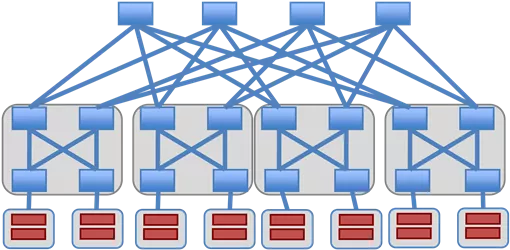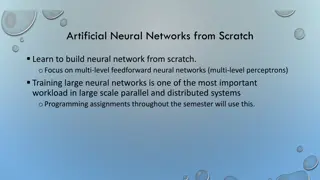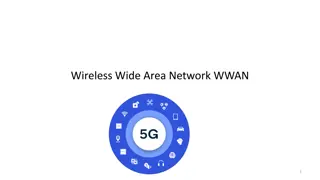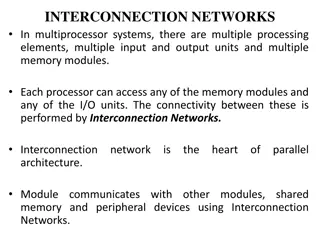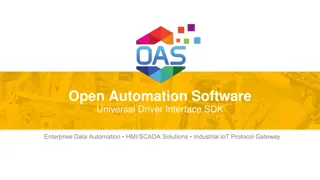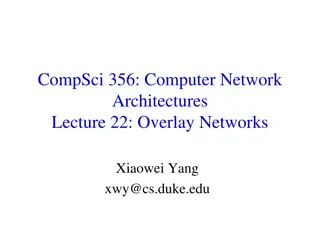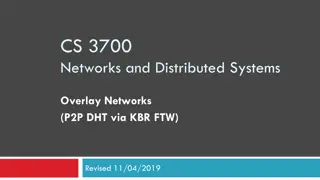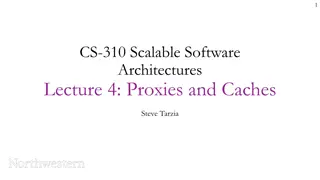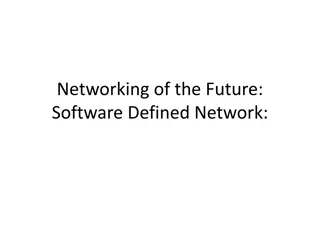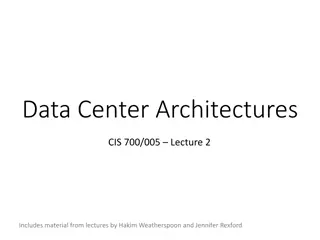Evolution of Data Center Networks Towards Scalable and Seamless Connectivity
Evolution of Data Center Networks highlights the need for networks in data centers to support diverse applications with high throughput and low latency, utilize multiple paths, and scale efficiently. The evolution from flat and hierarchical addressing to solutions like PARIS addresses issues such as seamless mobility and scalability. Overlay solutions like Portland/VL2 introduce new challenges in addressing schemes while aiming for seamless mobility and multipath routing.
Download Presentation

Please find below an Image/Link to download the presentation.
The content on the website is provided AS IS for your information and personal use only. It may not be sold, licensed, or shared on other websites without obtaining consent from the author. Download presentation by click this link. If you encounter any issues during the download, it is possible that the publisher has removed the file from their server.
E N D
Presentation Transcript
ProActive Routing In Scalable Data Centers with PARIS Theophilus Benson Duke University Joint work with Dushyant Arora+ and Jennifer Rexford* +Arista Networks *Princeton University
Data Center Networks Must Support diverse application High throughput/low latency Utilize multiple paths Scale to cloud size 5-10 million VMs Support flexible resource utilization Support seamless VM mobility
Evolution of Data Center Networks Multipath routing Seamless mobility Scalable Layer 2: Flat Addresses Layer 3: Hierarchical Addresses Overlays: VL2/Portland PARIS
PARIS in a Nutshell PARIS is a scalable and flexible flat layer 3 network fabric. PARIS hierarchically partitions addresses at the core PARIS runs on a data center of commodity switches
Outline Evolution of Data Center Networks PARIS Architecture Evaluation and Conclusion
Evolution of Data Center Networks Not scalable Seamless mobility No Multipath Flat layer 2: Spanning Tree Uses flooding to discover location of hosts Supports seamless VM migration Traffic restricted to single network path
Evolution of Data Center Networks Scalable No seamless mobility Multipath Layer 3:Hierarchical Addresses Host locations are predefined During VM mobility, IP-addresses change Load balances over k shortest paths
Evolution of Data Center Networks Seamless mobility Multipath Not scalable Overlay solutions: Portland/VL2 Uses two addressing schemes: hierarchical addresses: for routing traffic flat addresses: for identifying VMs
Overheads introduced by Overlays Solutions Flat-Address Resolve Hierarchical- Address Address resolution infrastructure Inflated flow startups times Switch CPU for encapsulation Switch storage for caching address resolutions
Evolution of Data Center Networks Multipath routing Seamless mobility Scalable Layer 2: Flat Addresses Layer 3: Hierarchical Addresses Overlays: VL2/Portland
Challenges.. Develop data center network that supports benefits of overlay routing while eliminating .. Overheads of caching and packet-encapsulation Overheads of address translation
ProActive Routing In Scalable PARIS Architecture
Architectural Principles Flat layer-three network Allows for seamless VM mobility Proactive installation of forwarding state Eliminates startup latency overheads Hierarchical partitioning of network state Promotes scalability
Paris Architecture Network Controller: Monitors network traffic Performs traffic engineering Tracks network topology Pro-actively installs forwarding entries Overheads eliminated Network Controller Pro-active rule installation No start-up delay for switch rule installation No addresses indirection No address resolution, encapsulation, caching /32 network addresses No broadcast traffic; no ARP Switches: Support ECMP Programmable devices End-Hosts: /32 addresses Default GW: edge switch
Evolution of Data Center Networks Multipath routing Seamless mobility Scalable Layer 2: Flat Addresses Layer 3: Hierarchical Addresses Overlays: VL2/Portland PARIS
Paris Network Controller Switches have 1 million entries But data center has 5-10 million VMs Each pod has ~100K VMs Partition IP-Address across core devices Core-Addressing Pod-Addressing Network Controller Pod switch track addresses for all VMs in the pod
Pod-Addressing Module 10.10.10.3 10.10.10.4 10.10.10.1 10.10.10.2 Edge & aggregation addressing scheme Edge: stores address for all connected end-hosts Pod: stores addresses for all end-hosts in pod
Pod-Addressing Module 10.10.10.1->1 10.10.10.2->1 10.10.10.3->2 10.10.10.4->2 10.10.10.1->2 10.10.10.2->2 10.10.10.3->1 10.10.10.4->1 2 3 10.10.10.1->1 10.10.10.2->1 default->(2,3) 10.10.10.3->1 10.10.10.4->1 default->(2,3) 1 10.10.10.3 10.10.10.4 10.10.10.1 10.10.10.2 Edge & aggregation addressing scheme Edge: stores address for all connected end-hosts Agg: stores addresses for all end-hosts in pod
Core Addressing-Modules 10.0.0.0/14 Partitions the IP-space into virtual-prefix Each core is an Appointed prefix switch (APS) Tracks all address in a virtual-prefix
Core Addressing-Modules 10.0.0.0/16 10.1.0.0/16 10.2.0.0/16 10.3.0.0/16 10.0.0.0/15 Partitions the IP-space into virtual-prefix Each core is an Appointed prefix switch (APS) Tracks all address in a virtual-prefix
Core Addressing-Modules 10.0.0.0/16 10.1.0.0/16 10.2.0.0/16 10.3.0.0/16 10.0.0.0/15 Partitions the IP-space into virtual-prefix Each core is an Appointed prefix switch (APS) Tracks all address in a virtual-prefix
DIP:10.0.0.0/16->{1,2} DIP:10.1.0.0/16->{3,4} 1 2 4 3 DIP:10.3.0.3->2 DIP:10.3.0.4->2 DIP:10.0.0.3->2 DIP:10.0.0.4->2 DIP:10.3.0.1->1 DIP:10.3.0.2->1 DIP:10.0.0.1->1 DIP:10.0.0.2->1 DIP:10.0.0.0/16->3 DIP:10.3.0.2->1 DIP:10.2.0.0/16->3 DIP:10.0.0.0/16->4 DIP:10.1.0.0/16->4 DIP:10.3.0.0/16->3 DIP:10.1.0.0/16->3 DIP:10.2.0.0/16->4 DIP:10.3.0.0/16->4 2 1 2 1 DIP:10.3.0.1->1 DIP:10.3.0.2->1 DIP:*.*.*.*->{2,3} DIP:10.0.0.1->1 DIP:10.0.0.2->1 DIP:*.*.*.*->{2,3} 10.0.0.1 10.3.0.1
Evaluation How does PARIS scale to large data centers? Does PARIS ensure good performance? How does PARIS perform under failures? How quickly does PARIS react to VM migration?
Evaluation How does PARIS scale to large data centers? Does PARIS ensure good performance? How does PARIS perform under failures? How quickly does PARIS react to VM migration?
TestBed Emulate data center topology using Mininet Generate traffic using IPerf Random traffic traffic matrix Implemented PARIS on NOX Data center topology 32 hosts, 16 edge, 8 aggregation, and 4 core No over-subscription Link capacity: Server Uplinks: 1Mbps Switch-Switch: 10Mbps
Scaling to Large Data Centers 1200000 128 ports* 1000000 800000 Hosts 600000 400000 200000 0 4000 16000 Flow table size 32000 64000 NoviFlow has developed switches with 1 million entries [1]. [1] NoviFlow. 1248 Datasheet. http://bit.ly/1baQd0A.
Does PARIS Ensure Good Performance? How low is latency? Recall: random traffic matrix. Communication Pattern Latency Inter-pod 61us Intra-pod 106us
Summary PARIS achieves scalability and flexibility Flat layer 3 network Pre-positioning forwarding state in switches Using topological knowledge to partition forwarding state Our evaluations show that PARIS is practical! Scales to large data-centers Can be implemented using existing commodity devices



